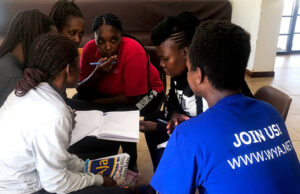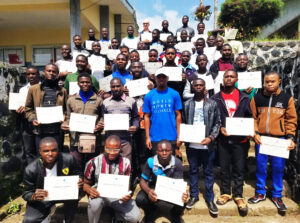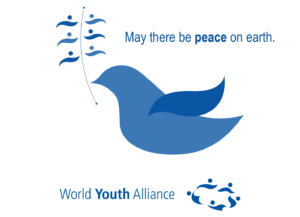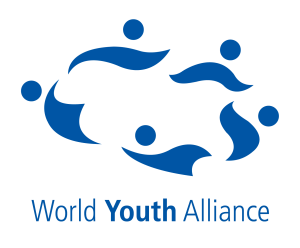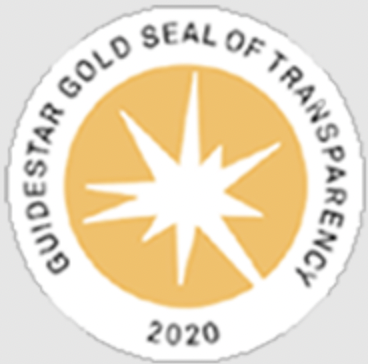This is the second in a two-part series describing WYA’s innovative Human Dignity Curriculum (HDC). Please click here to see part one.
The approach taken by WYA in developing the Human Dignity Curriculum (HDC) and its associated optional teenFEMM module is multi-layered.
The HDC is an effective personal development education program, patterned on proven strategies, which impacts student behavior in measurable ways. The HDC teaches social, emotional, cognitive, behavioral, and moral competence that foster self-determination, self-efficacy, and clear and positive identity. The HDC thus represents a positive vision for integrating sex education into a broader framework of character education.
Best practices in personal development and sexual education programs recognize that a clear personal awareness needs to be developed as a meaningful part of an individual’s worldview, consistent with reason and human experience. This opens opportunities for future and goal-oriented thinking. Once students possess a fundamental understanding of their own dignity, they have a basis from which to address the big questions they encounter in their lives as well as to see how they contribute to the community and world in which they live. Each lesson focuses on the “big picture” theme of how a proper understanding of the human person leads to human flourishing—helping students to understand and develop healthy habits, good decision-making skills, and a strong sense of meaning and purpose.
The HDC represents a positive vision for integrating sex education into a broader framework of character education.
A sexual education module is introduced with the sixth grade (ages 11-12), but is preceded by seven hours of instruction in personal development and is integrated within a commitment to achieving human excellence in one’s own behaviors and choices. TeenFEMM offers an integrated approach to health that better meets the internationally agreed-upon understanding that reproductive health is itself a factor in overall physical and mental health.
The first important takeaway from the international consensus documents is that they propose a holistic vision of sex education. The HDC grounds sexuality in the psychological and biological development and functioning of the human person. It shows how knowledge of human development and reproductive functioning may be used to recognize and attain health, regardless of one’s particular aims or state in life.
Another point of international consensus is “opposition to prejudicial traditional practices” like discrimination against menstruating women. By teaching that menstruation as part of an ovulatory cycle is a sign of health, teenFEMM gives young women conceptual tools to oppose such prejudices.
International standards rightly insist that sex education should involve international cooperation, modern teaching methods, and be sensitive to the needs of developing countries as well as age-appropriate. HDC uses a validated direct-instruction paradigm known to be the best method for pubescent-age learners and has adapted its program as a result of feedback from its pilot programs. Rather than offer one generic program, HDC offers tailored modules for each grade level.
The most fundamental tenet of sex education is that it must provide comprehensive and factual scientific knowledge. HDC/teenFEMM achieves this through its extensive reliance on scientific research (including the physiology of reproduction and reproductive and sexual health). The program provides information women typically lack and this helps them achieve informed consent with respect to their reproductive capacities and their state of health, including avoiding sexually transmitted diseases and seeking medical care as informed participants.
HDC recognizes that adolescent sexuality does not occur in a vacuum. Its emphasis on integral development within the context of the family recognizes the centrality of the family in international law and achieves improved sexual health outcomes.
Finally, HDC recognizes that adolescent sexuality does not occur in a vacuum. Its emphasis on integral development within the context of the family recognizes the centrality of the family in international law and achieves improved sexual health outcomes.
The HDC was developed by the WYA in collaboration with a research and development committee of experienced educators, curriculum developers, and medical doctors, and is designed for implementation at local, national, and international levels.
Appendix: International Agreements Governing Sex Education
International standards are grounded in the UN Convention for the Rights of the Child (CRC), passed in 1990. CRC explicitly applies rights taken from the Universal Declaration of Human Rights and other agreements to children. With relevance to sex education, it provides that:
-
States Parties recognize the right of the child to the enjoyment of the highest attainable standard of health and to facilities for the treatment of illness and rehabilitation of health. ¶24.1
-
[States Parties are] to develop preventive health care, guidance for parents and family planning education and services. ¶24.2f
-
States Parties shall take all effective and appropriate measures with a view to abolishing traditional practices prejudicial to the health of children. ¶24.3
-
States Parties shall promote and encourage international cooperation in matters relating to education, in particular with a view to contributing to the elimination of ignorance and illiteracy throughout the world and facilitating access to scientific and technical knowledge and modern teaching methods. In this regard, particular account shall be taken of the needs of developing countries. ¶28.3
-
States Parties agree that the education of the child shall be directed to: (a) The development of the child’s personality, talents and mental and physical abilities to their fullest potential; (b) The development of respect for human rights and fundamental freedoms, and for the principles enshrined in the Charter of the United Nations; (c) The development of respect for the child’s parents, his or her own cultural identity, language and values, for the national values of the country in which the child is living, the country from which he or she may originate, and for civilizations different from his or her own; (d) The preparation of the child for responsible life in a free society, in the spirit of understanding, peace, tolerance, equality of sexes, and friendship among all peoples, ethnic, national and religious groups and persons of indigenous origin; The development of respect for the natural environment. ¶29.1
Sex education received a non-binding expression of political will at the 1994 International Conference on Population and Development in Cairo. The participating States proposed:
-
Everyone has the right to the enjoyment of the highest attainable standard of physical and mental health. States should take all appropriate measures to ensure, on a basis of equality of men and women, universal access to health-care services, including those related to reproductive health care, which includes family planning and sexual health. Reproductive health-care programs should provide the widest range of services without any form of coercion. All couples and individuals have the basic right to decide freely and responsibly the number and spacing of their children and to have the information, education and means to do so. §2.8
-
Reproductive health is a state of complete physical, mental and social well-being and not merely the absence of disease or infirmity, in all matters relating to the reproductive system and to its functions and processes. Reproductive health therefore implies that people are able to have a satisfying and safe sex life and that they have the capability to reproduce and the freedom to decide if, when and how often to do so. Implicit in this last condition are the right of men and women to be informed and to have access to safe, effective, affordable and acceptable methods of family planning of their choice, as well as other methods of their choice for regulation of fertility which are not against the law, and the right of access to appropriate health-care services that will enable women to go safely through pregnancy and childbirth and provide couples with the best chance of having a healthy infant. §7.2
-
[States should meet] the educational and service needs of adolescents to enable them to deal in a positive and responsible way with their sexuality. §7.3
-
All ‘individuals of appropriate ages’ should have access to ‘education and counseling, as appropriate, on human sexuality, reproductive health, and responsible parenthood.’ This information should be ‘comprehensive and factual’ and help adolescents ‘understand their sexuality and protect them from unwanted pregnancies, sexually transmitted diseases and subsequent risk of infertility.’ §7.6
These goals were further elaborated at the Fourth World Conference on Women in Beijing the following year, which stated that:
-
[Sex education should take] into account the rights of the child to access to information, privacy, confidentiality, respect and informed consent, as well as the responsibilities, rights and duties of parents and legal guardians to provide, in a manner consistent with the evolving capacities of the child, appropriate direction and guidance in the exercise by the child of the rights recognized in the Convention on the Rights of the Child, and in conformity with the Convention on the Elimination of All Forms of Discrimination against Women. In all actions concerning children, the best interests of the child shall be a primary consideration. Support should be given to integral sexual education for young people with parental support and guidance that stresses the responsibility of males for their own sexuality and fertility and that help them exercise their responsibilities. ¶267
-
[States should] ensure education and dissemination of information to girls, especially adolescent girls, regarding the physiology of reproduction, reproductive and sexual health, as agreed to in the Program of Action of the International Conference on Population and Development and as established in the report of that Conference, responsible family planning practice, family life, reproductive health, sexually transmitted diseases, HIV infection and AIDS prevention, recognizing the parental roles referred to in paragraph 267. ¶281e
These provisions, while non-binding, suggest an international consensus that sex education should be holistic and scientific. Thankfully, so-called comprehensive sex education is not the best or only way to achieve these outcomes.
Brother R. Thomas-Martin Miller is an Intern for WYA North America.
You can make a difference in a child’s life. Follow this link to find out more about WYA’s Human Dignity Curriculum as well as other WYA Programs.

